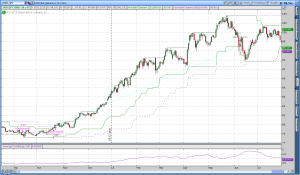Donchian Channel Breakout Trend Following Trading System
One of the main tenets of trend following is that you should use numerous, uncorrelated underlyings for diversification and to increase the returns in your system. Using additional trend following systems and non-trend following systems is an extension of that idea. The credit spread trading I generally discuss came about as a way to diversify the Donchian Channel system trade.

Using a Donchain Channel Breakout system is not a new idea. Richard Dennis, a famous trader, taught groups of people to trade using breakout systems and strict risk management. His Turtle Trading Rules have been extremely influential in my own trading. The Turtle Trading system was a simple trend following model that bet small amounts so that the numerous losing trades could be overcome with large winning trades.
The rules of a Donchian breakout trading system rules for long trades generally involve buying the high of a certain number of days and then selling the low of a certain number of days when price breaks down. For example, a system might buy the fifty day high for the Euro and then sell out of the position when the Euro makes a new 25 day low. The rules for short trades are usually the reverse of the long rules.
The Donchian Trading system is fairly simple to apply, but is incredibly powerful. I currently trade a Donchian Channel system on the following underlings:
Forex (currency pairs):
USD/JPY
EUR/USD
USD/CHF
NZD/JPY
ETF’s:
SPY (S&P 500)
IYR (US Real Estate)
RWX (International Real Estate)
TLT (20+ Year US Bonds)
FXI (Chinese Stocks)
GREK (Greek Stocks)
WIP (International Inflation Protected Bonds)
JO (Coffee)
BAL (Cotton)
SGG (Sugar)
DBA (The grains)
DBE (Energy)
GLD (Gold)
The rules in a nutshell for entries and exits are:
Buy new 50 day highs and Sell Short 50 day lows. The initial stop is placed at 3x the 14 day average true range or the 25 day low (for long positions) or high (for short positions). Positions are sized based on a percentage of notional account equity. For example, a $10,000 account would risk say 1% or $100 per trade. To determine the share size, you divide the risk per trade by 3x the average true range .
Here’s a numerical example:
Say the underlying is trading at $100 or so with a 14 day average true range of $1.50 and a long signal is triggered. If our risk size is $100, we can trade:
(100-round trip commission)/(3*1.5) = 90/4.5 = 20 shares
Our initial stop would be placed at 100-3*1.5 = 100-4.5 = 95.50 unless the 25 day low is greater than 95.50
The extensions of a Donchian system can and should include dynamic risk management and position sizing. Essentially, as the system enters a drawdown the amount of risk should be reduced to slow the drawdown.
The primary limitation of trading a Donchian trend following system with a small account is the account size. Trend following systems work well when they can be traded on a wide range of underlying markets and historically trend following systems have been applied to numerous futures markets. The main benefit of trading a trend following system on a futures market is that position risk is the same for every position, but capital can be used in a much more effective manner. The leverage found on a futures contract frees up more capital and allows the system to trade a greater number of markets.
In my personal trading, I have found that trading a Donchian breakout system combined with a trend following options strategy works well. That being said, the only way to trade numerous systems on a wide range of markets is to have clearly defined rules in place before trading.
2 thoughts on “Donchian Channel Breakout Trend Following Trading System”
Comments are closed.